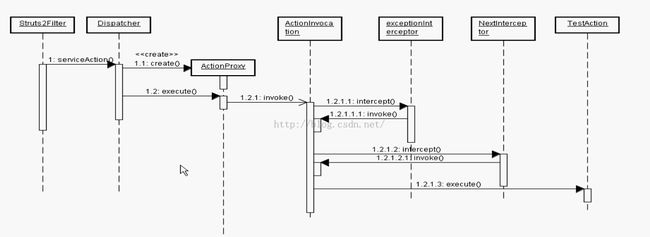【Struts2框架】第六节拦截器-拦截器的几个小实例
在看拦截器的小例子的前我们先来看看sturts2的原理
struts2自己是有拦截器的,通过拦截器可以拦截用户请求,并作出处理
拦截器作用有很多,譬如:
1.Action里面有个属性,这个属性我想在action执行之前改成别的值,可以用拦截器解决。
2.比如每个人执行action之前,我可以查看他们有没有这个权限执行这个action。
如果不设置拦截器,你要在每种action方法之前设置判定程序,非常繁琐。
拦截器interceptor体现了一种编程理念,叫做AOP(面向切面编程)
实例1:使用token拦截器控制重复提交
token是用来解决下面的问题:
一旦有人通过表单提交数据,在提交表单的时候页面提交速度太慢,用户一直不停的刷新,如果不做一种机制防止他刷新的话,那么数据库中就会多出好多垃圾数据。
表单提交一般都要写成post(第一种解决方式,浏览器会提醒你是否重复提交)
拦截器解决方法:
struts2定义了一个拦截器(interceptor)叫--token
token的意思是“令牌”,你要提交数据,我先发给你一个令牌,你的令牌要是和我能对上,你就提交,对不上就不允许提交
token为什么可以防止重复提交?
答:当访问界面时,在服务器那边的session里面,生成一个随机数,然后再把随机数写到form里,提交数据时session就会被带到服务器去。提交完成后session里面的值被清空,再次重复提交的时候,发现此token值在session不存在,说明已经被提交过了,这个时候就会显示友好界面提示用户。
实现代码:
struts.xml:
<package name="test" namespace="/javaee" extends="struts-default"> <action name="pinput" class="cn.edu.hpu.action.PinputAction"> <result>/input.jsp</result> </action> <action name="person" class="cn.edu.hpu.action.PersonAction"> <result>/addOK.jsp</result> <interceptor-ref name="defaultStack"></interceptor-ref> <interceptor-ref name="token"></interceptor-ref> <result name="invalid.token">/error.jsp</result> </action> </package>
PersonAction.java:
package cn.edu.hpu.action;
import com.opensymphony.xwork2.ActionSupport;
public class PersonAction extends ActionSupport {
private String name;
private int age;
@Override
public String execute() throws Exception {
System.out.println("a person added!");
return super.execute();
}
public String getName() {
return name;
}
public void setName(String name) {
this.name = name;
}
public int getAge() {
return age;
}
public void setAge(int age) {
this.age = age;
}
}
input.jsp:
<%@ page language="java" import="java.util.*" pageEncoding="utf-8"%>
<%
String path = request.getContextPath();
String basePath = request.getScheme()+"://"+request.getServerName()+":"+request.getServerPort()+path+"/";
%>
<!DOCTYPE HTML PUBLIC "-//W3C//DTD HTML 4.01 Transitional//EN">
<html>
<head>
<base href="<%=basePath%>">
<title>My JSP 'input.jsp' starting page</title>
</head>
<body>
<form action="<%=basePath %>javaee/person" method="post">
name:<input name="name">
age:<input name="age">
<input type="submit" value="add">
</form><br/>
</body>
</html>
addOK.jsp:
<!DOCTYPE HTML PUBLIC "-//W3C//DTD HTML 4.01 Transitional//EN">
<html>
<head>
<title>My JSP 'addOK.jsp' starting page</title>
</head>
<body>
add ok!! <br/>
</body>
</html>
error.jsp:
<%@ page language="java" import="java.util.*" pageEncoding="UTF-8"%>
<%
String path = request.getContextPath();
String basePath = request.getScheme()+"://"+request.getServerName()+":"+request.getServerPort()+path+"/";
%>
<!DOCTYPE HTML PUBLIC "-//W3C//DTD HTML 4.01 Transitional//EN">
<html>
<head>
<base href="<%=basePath%>">
<title>My JSP 'error.jsp' starting page</title>
</head>
<body>
严禁做重复的事!!! <br>
</body>
</html>
结果:
填写name与age之后,会跳入界面addOK.jsp,控制台会输出a person added!
返回再次提交时,就会跳转到error.jsp界面,无法重复提交
如果在表单中加<s:token></s:token>,则会看到源码:
<input type="hidden" name="struts.token.name" value="struts.token" /> <input type="hidden" name="struts.token" value="PZOQNKARYVQYDEVGNKTWFBF17735K6AI" /> <!--相当于生成了一个随机数-->
所原理是:在提交页面形成了一个token,这个token在服务器端对应的session里面已经有了,当我一点提交的时候,由于加了<interceptor-ref name="token"></interceptor-ref>(token的拦截器),服务器就会帮我拦截,看看session里面有没有token的值,如果之前没有提交,session里面是有这个token值的,如果上次提交过了,session就会将token值清除掉。当发现页面的token值在服务器的session中找不到时,服务器发现出错了,重定向到error.jsp,显示错误信息
实例2:自定义拦截器
struts.xml:
<pre name="code" class="html"><pre name="code" class="html"><pre name="code" class="html"><pre name="code" class="html"><?xml version="1.0" encoding="GBK" ?>
<!--指定struts2配置文件的DTD信息-->
<!DOCTYPE struts PUBLIC
"-//apache Software Foundation//DTD Struts Configuation 2.0//EN"
"http://struts.apache.org/dtds/struts-2.0.dtd">
<!-- struts 是struts2配置文件的根元素-->
<struts>
<constant name="struts.devMode" value="true"></constant>
<constant name="struts.i18n.encoding" value="UTF-8"></constant>
<!--允许静态方法的执行-->
<constant name="struts.ognl.allowStaticMethodAccess" value="true"></constant>
<package name="test" namespace="/" extends="struts-default">
<interceptors>
<interceptor name="my" class="cn.edu.hpu.interceptor.MyInterceptor"></interceptor>
</interceptors>
<action name="test" class="cn.edu.hpu.action.TestAction">
<result>/test.jsp</result>
<interceptor-ref name="my"></interceptor-ref>
<interceptor-ref name="defaultStack"></interceptor-ref>
</action>
</package>
</struts>
TestAction.java:
package cn.edu.hpu.action;
import com.opensymphony.xwork2.ActionSupport;
public class TestAction extends ActionSupport{
@Override
public String execute() throws Exception {
// TODO Auto-generated method stub
return super.execute();
}
}
MyInterceptor.java:
package cn.edu.hpu.interceptor;
import com.opensymphony.xwork2.ActionInvocation;
import com.opensymphony.xwork2.interceptor.Interceptor;
public class MyInterceptor implements Interceptor{
public void destroy() {
}
public void init() {
}
//写好了一个拦截(计算了一个action运行的时间)
public String intercept(ActionInvocation invocation) throws Exception {
long start=System.currentTimeMillis();
String r=invocation.invoke();
long end=System.currentTimeMillis();
System.out.println("Action Time="+(end-start));
return r;
}
}
访问:http://localhost:8080/struts2_LanJieQi/test后
控制台输出:
Action Time=200
转载请注明出处:http://blog.csdn.net/acmman/article/details/47111009
